The NFL’s Eye in the Sky Sees Everything, Often More Than Once

ST. LOUIS — It’s the second quarter of the Rams’ preseason opener against the Saints, and there’s a loud, shrill ringing on the home team’s sideline. Loud, as in roughly 105 decibels, which is equivalent to a roaring chainsaw. The source: a black phone labeled INJURY REVIEW in red capital letters.
The man who placed the phone call is Tom Godar, a certified athletic trainer who is seated five stories up in the Edward Jones Dome, in booth No. 7, and watching the action with the intensity of a scout sniper. He has just seen something he doesn’t like. While trying to finish his block on a third-down pass, an offensive lineman was plowed into by a defender and knocked to the turf. Could he have suffered whiplash, or another kind of head or neck injury? Godar picked up the phone next to him and hit a button marked HME50, a direct line to the loud-ringing phone on the Rams’ 50-yard line.
“Can you put Reggie on?” he says, asking for Reggie Scott, the Rams’ head athletic trainer.
This is the beginning of a conversation that takes place anywhere between two and 10 times during every NFL game. In response to the Colt McCoy slip-up in 2011, when the Browns quarterback was brutally hit by Steelers linebacker James Harrison but returned to the game without being checked for a concussion, the league began hiring an independent injury-spotter to sit high above the field at every stadium.
In St. Louis, that duty belongs to Godar, who interned with the Rams in the early 2000s and is now the athletic trainer for the football team at nearby Lindenwood University. He’s a safety net for the medical teams on both NFL sidelines—another button on his phone is marked VST50, for the visitors’ 50-yard line, and he also exchanged calls with the Saints—and by the end of the night, he will have watched more video replays than anyone in the stadium.
The MMQB joined him in booth No. 7 last Friday night, taking in an NFL game through the perspective of the so-called “eye in the sky.” With the Rams’ permission, we chronicled the communication between their on-field medical staff and Godar. His stats for the night: four phone calls to the Rams, 13.85 GB of game footage reviewed, two diet Dr. Peppers and zero bathroom breaks—not even during halftime.
Tom Godar is the athletic trainer for the football team at Lindenwood University and the NFL’s independent injury spotter at Rams games. He can call down to either sideline on the phone shown here (or on a walkie-talkie) to alert medical staffs about players with whom they should consult. (Jenny Vrentas/The MMQB)

* * *
Two and a half hours before kickoff, two technicians and an NFL IT specialist begin setting up a command center in the private booth underneath the press box. The eye in the sky is more than just a pair of eyes. Godar can watch the game three ways: live through the binoculars; on the TV broadcast, which is on a two-second delay; or through the NFL Injury Video Review System, which uses an in-house feed on a six-second delay and records to the computer just like a DVR.
To Godar’s left sits Mike Eaves, an injury video technician. Eaves is a Division 2 on-field official who first worked with the Rams in 2008, when he was tasked with guarding the box containing the back-up radio helmet for the defensive signal-caller. Now he sits in booth No. 7, using, of all things, an X-Box controller to rewind, fast-forward and pause the in-house feed on a computer screen angled perpendicular to the field.
From top to bottom: Godar watching the action while Eaves rewinds game tape that is on a six-second delay; the sideline communications center; and Godar's injury stat sheet. (Jenny Vrentas/The MMQB)

Godar looks for all injuries, but he particularly keeps an eye out for contact to the head that the medical staff on the field might miss from their vantage points. Making a counterclockwise winding motion with his right index finger, Godar prompts Eaves to rewind and replay virtually every running play. Spotting the point of contact between the running back and the tackler in real time, he explains, is nearly impossible. Sacks, chop blocks, an illegal block in the back, a tumbling catch and any play in which a receiver is thrown to the ground also warrant a second look (and sometimes a third or fourth). He’s looking for a clear answer to a simple question: Did the player’s head and/or neck area collide dangerously with another player, or with the turf?
On the third-down play involving the Rams offensive lineman in the second quarter, most of the stadium sees an incomplete pass, broken up by the defender about 10 yards downfield. But Godar notices traffic back behind the line of scrimmage. First, he picks up his binoculars. Then, with Eaves controlling the joystick, he watches five replays. Finally, he places a call to the field.
There is another injury technician alternating between both teams’ sidelines; he works the same day job as Eaves at a local bank. He wears a bright blue hat, so he’s easy to spot, and he has three walkie-talkies tucked in the back of his belt: one to communicate with the teams’ medical staffs, one for the unaffiliated neuro-trauma consultants, and another for the airway management physician. When the roving tech hears the 105-decibel ringing, he scrambles to answer the phone, and then fetches a member of the team medical staff.
The NFL is now entering its third full season using the eye in the sky, so like a veteran defense, their communication is down pat. Scott, the team’s head athletic trainer, slips on a Bose headset with noise-canceling earmuffs—all the better to hear with inside the dome—and listens to Godar’s report on the offensive lineman.
“He took a blind hit,” Godar tells him, “and he was a little slow getting up.”
But Godar does more than just describe what happened; he shows Scott a replay. A yellow fiber-optic cable snakes from booth No. 7 underneath the stands, linking to a black cart called the sideline communications center. The injury review phone and TV are here, as well as the short-range WiFi router that powers the new Microsoft Surface tablets now being used by coaches on the sidelines. Scott unzips a cloth hood around the television, and with Eaves controlling the joystick upstairs, watches the tape just like an official would in the replay booth.
After taking off the headset, Scott seeks out the lineman along with the team’s primary care physicians. Godar is not issuing a diagnosis from upstairs—he’s just alerting the medical team to check in with the player, who is asked to answer a few brief questions about what happened in order to assess his orientation and mental function. In this case, the player’s head and neck weren’t injured in the collision, so he’s allowed to return to the game on the next series. But he’ll be tracked, both upstairs and downstairs, for the rest of the night.
* * *
The NFL’s Eye in the Sky Sees Everything, Often More Than Once
Rams tight end/defensive lineman Mason Brodine (87) looks for someone to block on a kickoff return late in the second quarter.
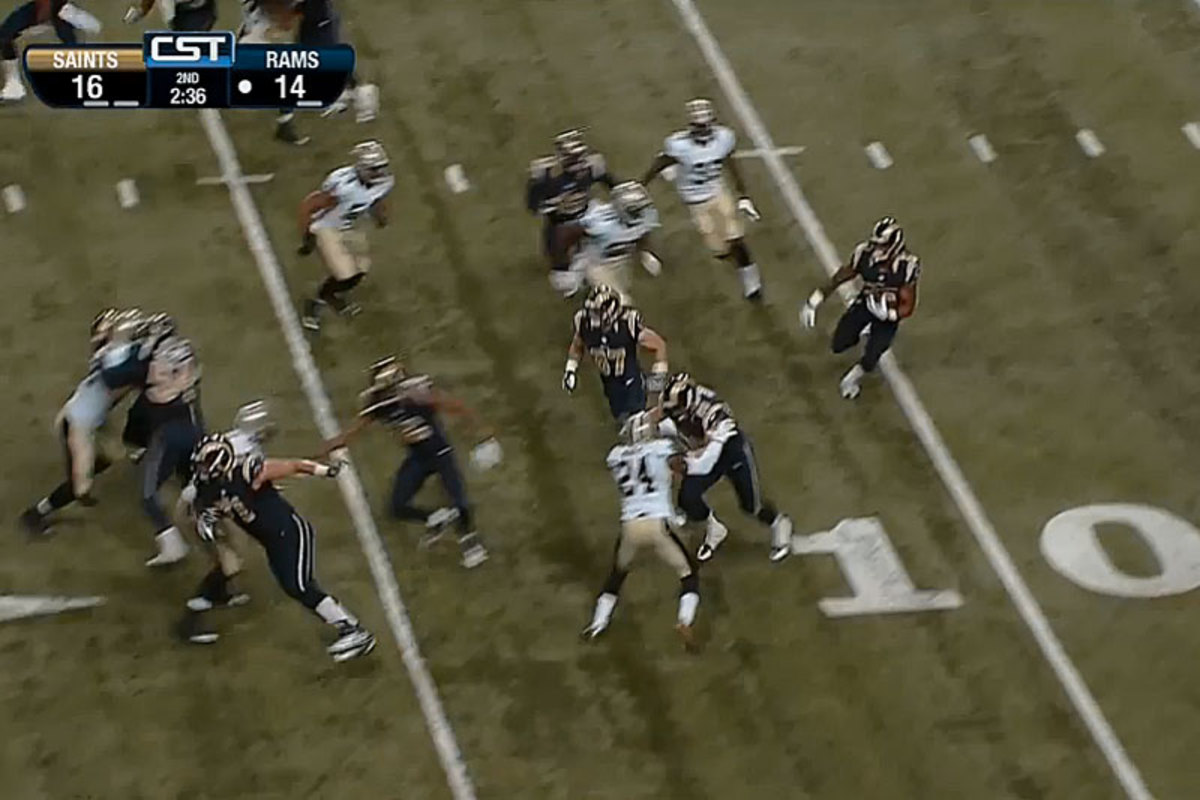
After shedding his initial blocker, Saints cornerback Corey White (24) squares up with Brodine.
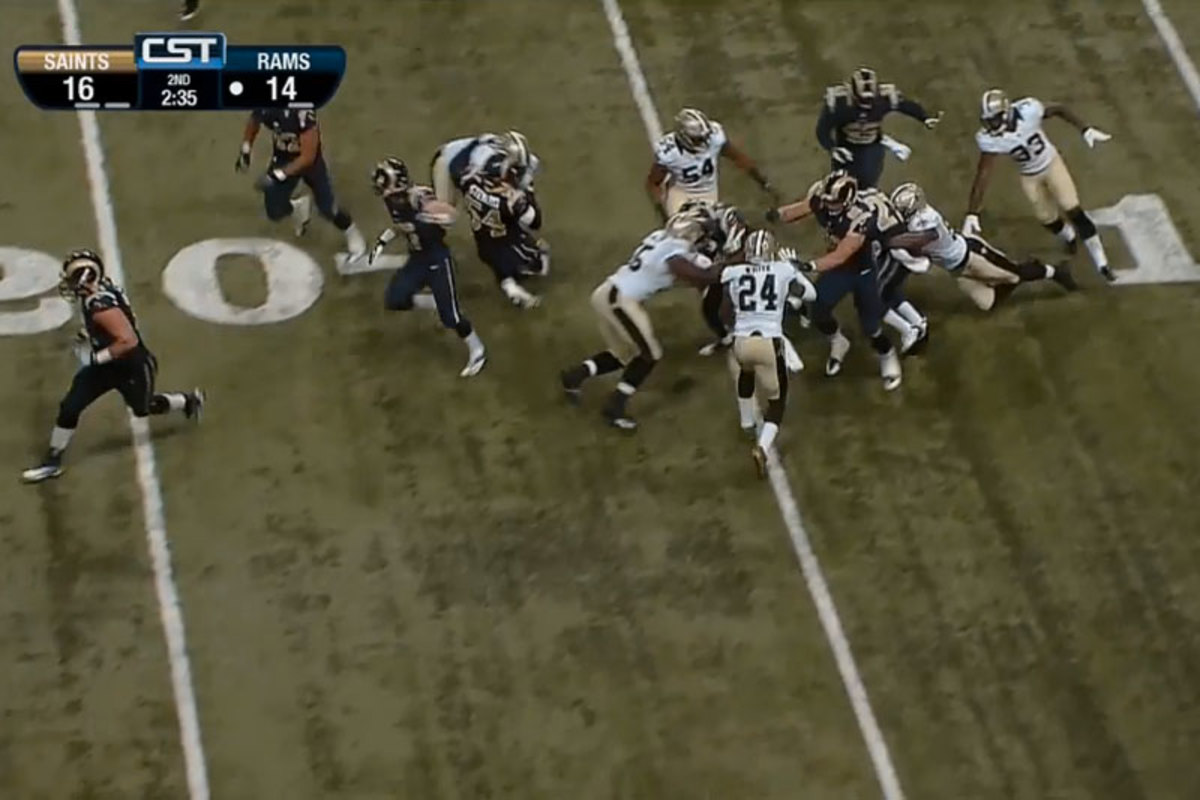
As running back Tre Mason is wrangled to the turf, another Saints defender falls on Brodine’s left leg, forcing Brodine’s weight to roll over his ankle and his foot to flop in an unnatural direction.
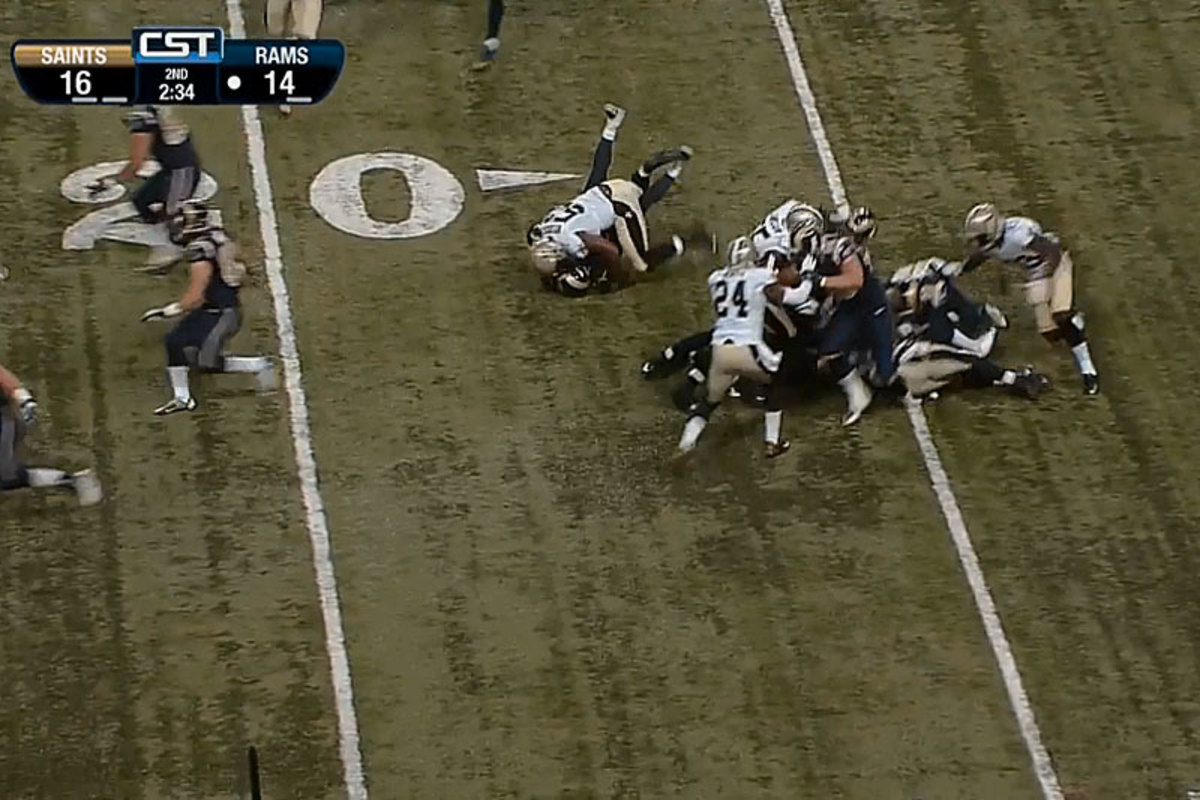
How Brodine’s injury looked to Godar and Eaves on the NFL Injury Video Review System, which operates on a six-second delay from the action.
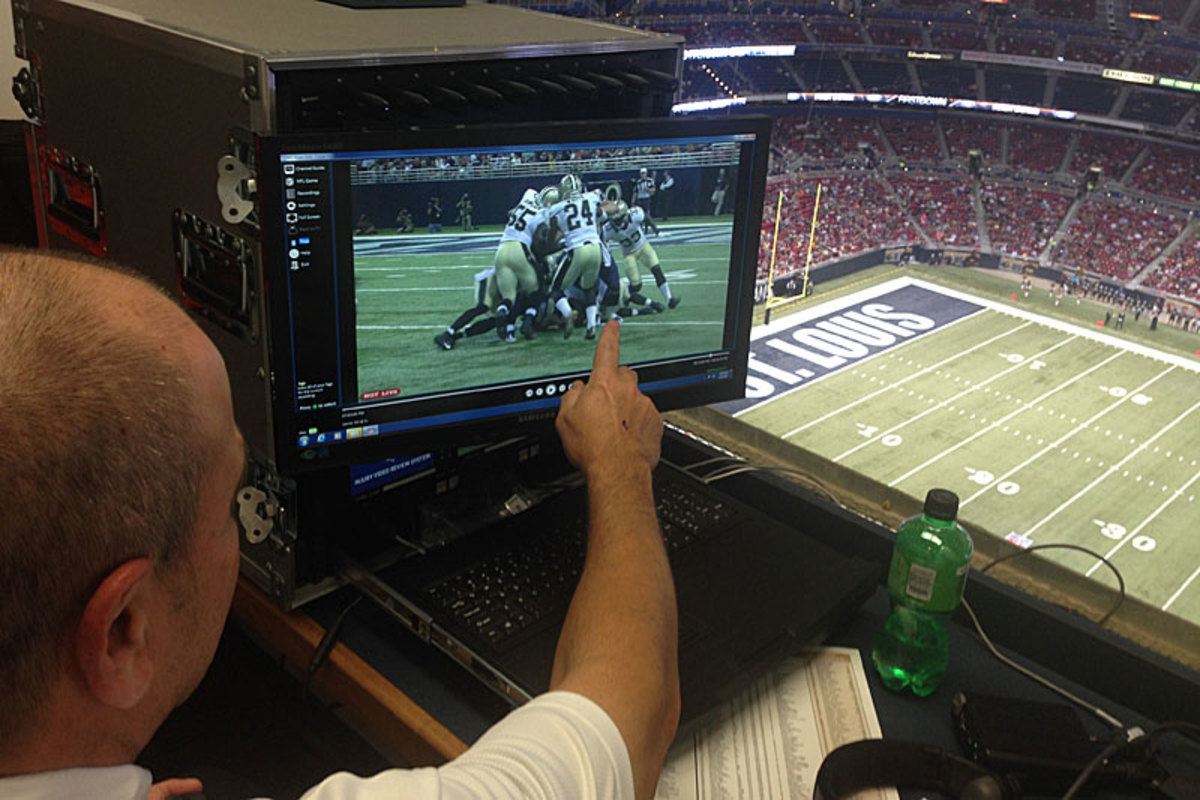
Brodine will miss the entire season with a broken ankle.
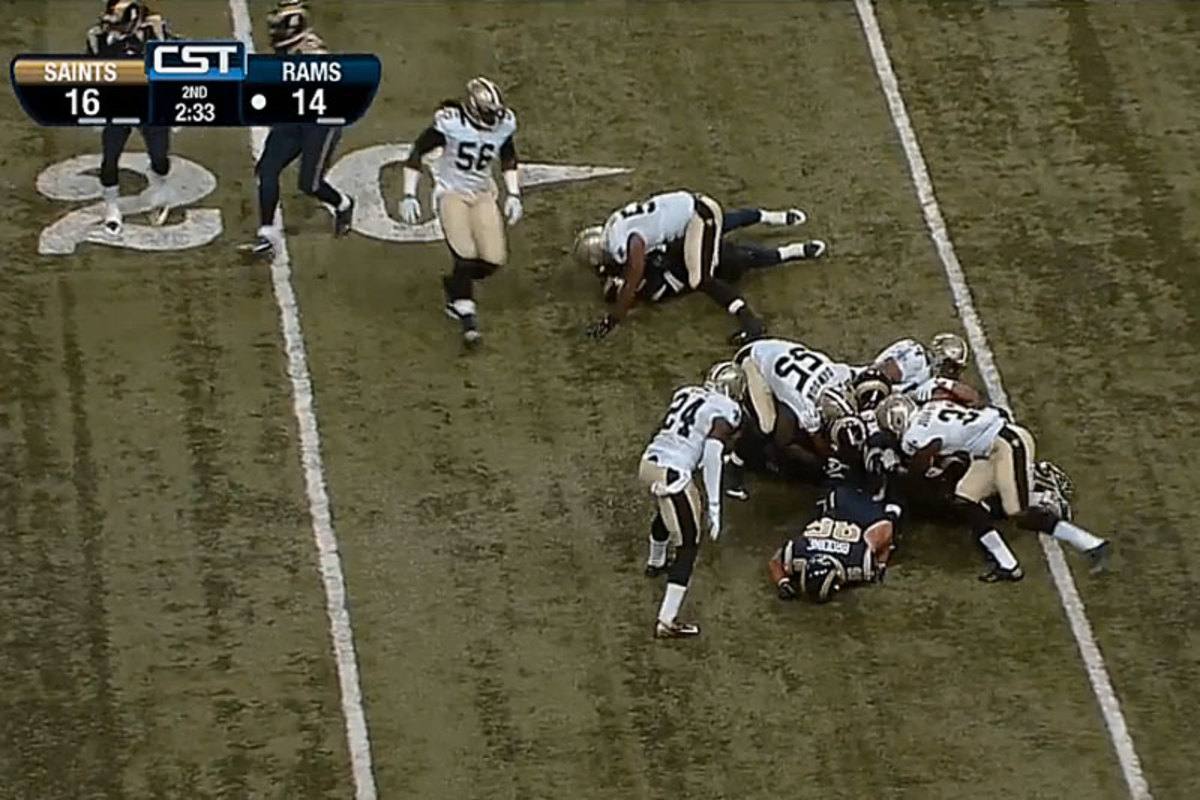
It’s a busy second quarter. After blocking on a kickoff return, Rams tight end and defensive lineman Mason Brodine is unable to put weight on his left foot. Scott and Rams team physician Matt Matava help Brodine off the field and over to the medical table while Godar reviews the footage upstairs.
There’s a cringeworthy camera angle that shows Brodine’s body rolling over the top of his left ankle and his foot flopping in a direction that it shouldn’t flop. “Tag that,” Godar tells Eaves. The injury review software allows them to save shots for future review. This tag reads: “2Q Rams #86 Brodine 2:36 left leg.” Godar waits until Matava, an orthopedic surgeon and president of the NFL Physicians Society, has examined the player. Then he calls down. “Dr. Matava? OK,” he says. “We’ve got a good picture of this.”
The TV at the 50-yard line is used only for injury reviews—coaches are forbidden from accessing it for any reason—and is set to a blue screen with the NFL shield until Eaves pushes a button upstairs to begin a review. Matava unzips the hood and watches the replay. X-Rays will be taken later, but after seeing how the injury happened, he’s already confident in the diagnosis: a fractured ankle. Brodine is carted off the field, and after the game, coach Jeff Fisher will announce that he’s done for the season.
Coaches are forbidden from accessing the injury-review TV on the 50-yard line.
After this incident, Godar glances up and realizes he has no idea who’s winning. That’s par for the course. He keeps a running stat sheet, but it’s different from any other in the building. It’s a log of each injury he sees: The player’s name, the time, a description of what happened, if and when he called down to the sideline, who initiated the call, and whether or not video of the injury was reviewed on the sideline. On Saturday morning, he’ll type up these notes and send the file to NFL headquarters for review.
Sometimes the sideline medical staff initiates a call upstairs. This happens late in the third quarter, when another tight end comes up limping on his right leg. The player isn’t very descriptive about what happened, so Matava seeks out the replay for more information. This time, however, the video footage doesn’t give a clear picture either. Godar’s phone has a third button, TRUCK, which he can use to request extra camera angles from the broadcast truck. But in this case, Matava relies on the physical exam and deems the player OK to return.
MORE VRENTAS: How stem cell treatment has moved from the shadows to the NFL’s cutting edge
Since cramming in a six-minute dinner of chicken, couscous and green beans just before kickoff, Godar hasn’t had any down time. He uses breaks in the action to watch replays, test the phone line or scan the sidelines with binoculars for players receiving medical attention. The rise in no-huddle offenses has made his job more hectic, because he has less time between plays to review replays and scour for unseen injuries.
The in-house feed from the Rams Broadcast Network fades to a black screen during commercial breaks, and there’s always a moment of anxiety right before play resumes. The feed malfunctioned once last season and the screen stayed black. A back-up system is on stand-by in the officials’ locker room, so Eaves scrambled downstairs and communicated with the booth and the sidelines via walkie-talkie for the rest of that game. Godar stayed put, high above the 50-yard-line, where he has one of the best views in the house.
* * *
Godar crammed in a six-minute dinner just before kickoff and, despite downing two diet sodas, never left his post to use the bathroom until after the game. (Jenny Vrentas/The MMQB)

Booth No. 7 is usually the busiest in the fourth quarter of regular-season games, when players are fatigued and straining to make plays. But that’s not the case during the preseason, when teams distribute playing time among a 90-man roster. Godar calls down to the Rams’ sideline just once in the fourth quarter.
A runner tries to go airborne, and the Rams cornerback who makes the tackle starts adjusting his helmet afterward. Godar watches a replay, and it’s possible the defensive player took a knee to the head. This time, the play took place in clear view of the Rams’ sideline. By the time Godar calls down, Scott tells him that he and the primary-care physicians have already checked the player.
Godar is but a tiny piece of the puzzle, just one of the 27 medical personnel who are at every NFL game. But his eye-in-the-sky experience convinced him to implement the same practice at Lindenwood games; he puts one of his student assistants up in the press box with a walkie-talkie. The calls he doesn’t have to make at NFL games are just as important for a safer brand of football—like in the second quarter, when Rams safety Maurice Alexander pulled up while covering a deep pass, stopping short of the receiver as he sees that the throw is off-target. “That’s where we used to see a lot more injuries,” Godar says, “when guys wouldn’t lay off like that.”
At 10:20 p.m., the final seconds tick off the game clock. When the in-house feed ends, the 13.85GB of footage will be copied onto 10 flash drives, a transfer that takes four minutes, 37 seconds. This fresh, complete game footage is shared with the seven members of the officiating crew, who want the footage to review their own performance on their flights home, and the Rams’ video coordinator. But the primary purpose is for the teams’ medical staffs to be able to rewatch any injuries after the game. Godar will wait downstairs in the corridor to hand-deliver a flash drive to either the team physician or head athletic trainer of each team. As an independent spotter, he’s not allowed in either locker room.
But first, Godar is rewatching the final play on the six-second delay. When it’s over, Eaves turns and looks at him. “We’re good?” he asks. Godar flashes the thumbs-up. The eye in the sky can finally leaves his post. By the time he reaches his car, he’s just another spectator headed home.

